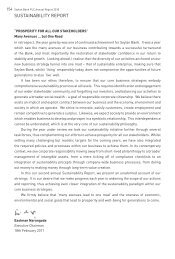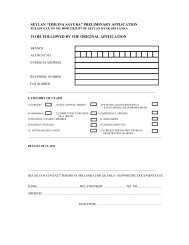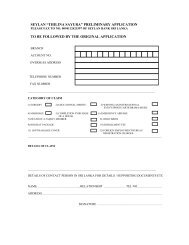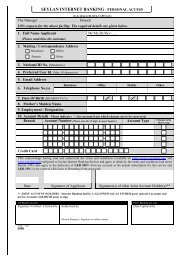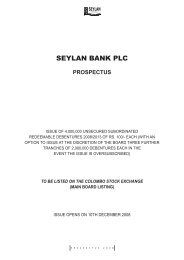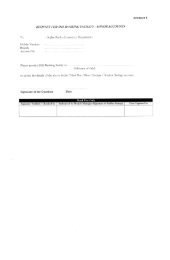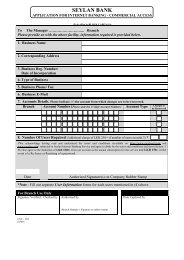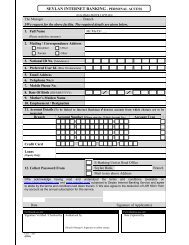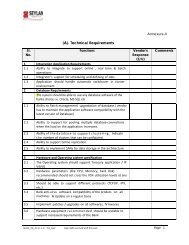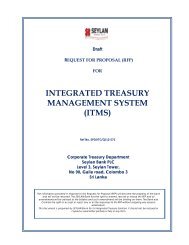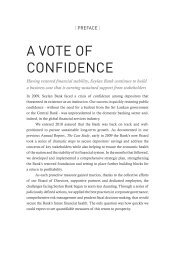The Case Study - Seylan Bank
The Case Study - Seylan Bank
The Case Study - Seylan Bank
Create successful ePaper yourself
Turn your PDF publications into a flip-book with our unique Google optimized e-Paper software.
70<strong>Seylan</strong> <strong>Bank</strong> PLC Annual Report 2009Liquidity RiskLiquidity Risk is the risk that an entity may not beable to meet the payments as they fall due. It appearsto be an insignificant risk that does not causeregular losses until such time a major event occursresulting in even a threat to the mere existence ofan organisation. <strong>Seylan</strong> views Liquidity Risk as animportant aspect in managing risks and pays seriousattention to the management of liquidity. <strong>The</strong> <strong>Bank</strong>underwent a potential liquidity crisis towards theend of year 2008 that was triggered by the externalevents, a situation referred to as ‘event risk’ thattriggered potential crystallising of liquidity risk.<strong>Bank</strong> always maintained its liquid assets in excessof the statutory requirement of 20% of liabilities;however as a result of the crisis the ratio fell to a rangeof 13%. Due to several measures taken by the <strong>Bank</strong>and the regulatory authority in meeting the challenges,the deposit base improved significantly and the ratiorestored much above the statutory minimum of 20% toa level of 29% by the end of the year 2009.Asset and Liability Maturity GapsAnother tool used by the <strong>Bank</strong> in the management oflong-term Balance Sheet Structure of the <strong>Bank</strong> is tomonitor the gap between the maturity of assets andliabilities under different time bands. This analysisshows the potential risks of mismatches betweenmaturity of assets and maturity of liabilities. <strong>Seylan</strong>uses this analysis in its risk management process andmonitors the maturity ladder at the ALCO meetingson a monthly basis. While it is typical for a bank tohave mismatches based on contractual maturities,it is also appropriate to analyse the maturities basedon behavioural patterns. <strong>Bank</strong> has set targets inreducing the mismatches over a time period.Treasury Management CommitteeThis Committee chaired by the Chief Executive Officer,meets on a daily basis to deal with matters relatingto liquidity management and market interest rates.In addition, foreign currency exposures are reviewedregularly. It is a strength of the <strong>Bank</strong> to have a focusedapproach through the Treasury Committee in itsliquidity management and management of the dayto day forex and money market exposures as well asmonitoring of the market rates for competitive andcurrent pricing of products.Compliance Function<strong>Bank</strong> has set up a separate Compliance Departmentspecialised in ensuring compliance with theregulatory and legal framework. <strong>The</strong> Departmentalso has set in place necessary systems andprocesses to comply with the Anti-Money LaunderingRegulations and Laws.<strong>The</strong> <strong>Bank</strong> has taken a serious view thatcompliance with all regulations is an essentialelement of good governance and management ofthe <strong>Bank</strong> and therefore, emphasis is made on thisaspect throughout the organisation.Information Technology Risk - <strong>The</strong> technologyteams and users meet regularly and review theinformation systems currently utilised by the <strong>Bank</strong>and analyse the future technology and systemsneeds of the organization to compete effectivelyand efficiently in the future. Additionally, key areasof focus include Information Security, BusinessContinuity Planning (BCP) and Data Security.Business Continuity Planning (BCP)BCP is a strategic and tactical approach of anorganisation to plan for and respond to incidents andbusiness disruptions in order to continue businessoperations at an acceptable pre-defined level.



